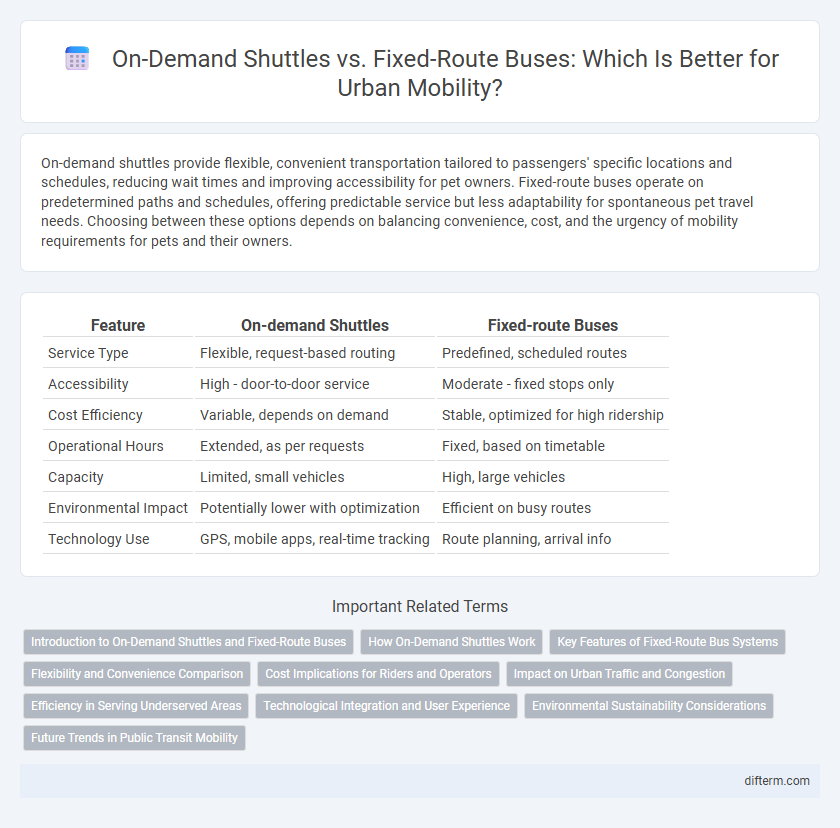On-demand shuttles provide flexible, convenient transportation tailored to passengers' specific locations and schedules, reducing wait times and improving accessibility for pet owners. Fixed-route buses operate on predetermined paths and schedules, offering predictable service but less adaptability for spontaneous pet travel needs. Choosing between these options depends on balancing convenience, cost, and the urgency of mobility requirements for pets and their owners.
Table of Comparison
| Feature | On-demand Shuttles | Fixed-route Buses |
|---|---|---|
| Service Type | Flexible, request-based routing | Predefined, scheduled routes |
| Accessibility | High - door-to-door service | Moderate - fixed stops only |
| Cost Efficiency | Variable, depends on demand | Stable, optimized for high ridership |
| Operational Hours | Extended, as per requests | Fixed, based on timetable |
| Capacity | Limited, small vehicles | High, large vehicles |
| Environmental Impact | Potentially lower with optimization | Efficient on busy routes |
| Technology Use | GPS, mobile apps, real-time tracking | Route planning, arrival info |
Introduction to On-Demand Shuttles and Fixed-Route Buses
On-demand shuttles provide flexible, real-time transportation tailored to passenger requests, reducing wait times and optimizing routes based on demand using GPS and mobile applications. Fixed-route buses operate on predetermined schedules and specific paths, offering consistent service with established stops that accommodate high passenger volumes and predictable traffic flow. Integrating on-demand shuttles can complement fixed-route systems by enhancing last-mile connectivity and serving areas with lower ridership efficiently.
How On-Demand Shuttles Work
On-demand shuttles operate using real-time ride requests via mobile apps, matching passengers with nearby vehicles to provide flexible pick-up and drop-off locations. These shuttles utilize dynamic routing algorithms to optimize routes based on demand, reducing wait times and improving efficiency compared to fixed-route buses. GPS tracking and data analytics enable continuous adjustments, enhancing service responsiveness in urban mobility ecosystems.
Key Features of Fixed-Route Bus Systems
Fixed-route bus systems operate on pre-determined schedules and established routes, allowing for predictable and reliable service coverage across urban and suburban areas. These systems feature fixed stops, enabling passengers to plan trips with consistent arrival and departure times, contributing to efficient mass transit management and reduced operational complexity. Integration with transit hubs and transfer points enhances connectivity, supporting high passenger volumes and reducing traffic congestion by promoting public transportation over private vehicle use.
Flexibility and Convenience Comparison
On-demand shuttles provide unmatched flexibility by allowing riders to request pickups and drop-offs at specific locations and times, adapting routes dynamically to passenger needs. Fixed-route buses offer scheduled service along predetermined paths, which ensures predictability but limits convenience for users outside standard stops or times. The convenience of on-demand shuttles significantly enhances urban mobility by reducing wait times and providing tailored transit solutions compared to the rigidity of fixed-route bus systems.
Cost Implications for Riders and Operators
On-demand shuttles reduce operational costs by optimizing routes and minimizing fuel consumption, leading to lower expenses for transit agencies compared to fixed-route buses that run on predetermined schedules regardless of passenger demand. Riders benefit from on-demand services through potentially lower fares and reduced wait times, while fixed-route buses may incur higher costs due to route inefficiencies and underutilized capacity. The financial trade-offs highlight the importance of analyzing ridership patterns and service frequency to balance affordability and efficiency in urban mobility solutions.
Impact on Urban Traffic and Congestion
On-demand shuttles dynamically adjust routes based on real-time passenger demand, reducing vehicle miles traveled and easing congestion in densely populated urban areas. Fixed-route buses, operating on predetermined schedules and paths, often contribute to traffic bottlenecks during peak hours due to inflexible stops and routes. Implementing on-demand shuttle services can optimize traffic flow and decrease urban congestion by minimizing empty or underutilized trips.
Efficiency in Serving Underserved Areas
On-demand shuttles improve efficiency in underserved areas by dynamically routing based on real-time demand, reducing wait times and minimizing empty miles compared to fixed-route buses. Fixed-route buses often run on predetermined schedules and routes that may not align with fluctuating passenger needs, leading to inefficiencies and limited coverage in low-density communities. Leveraging ride-matching algorithms, on-demand services optimize resource allocation and enhance mobility access in areas with sparse public transit infrastructure.
Technological Integration and User Experience
On-demand shuttles leverage advanced GPS and mobile app technology, offering real-time tracking and flexible routing that enhances user convenience and reduces wait times. Fixed-route buses incorporate automated scheduling and electronic fare collection systems, providing reliable service with predictable stops but limited adaptability. Integration of AI-driven algorithms in on-demand shuttles optimizes route efficiency, significantly improving user satisfaction compared to static fixed-route systems.
Environmental Sustainability Considerations
On-demand shuttles reduce emissions by optimizing routes based on real-time demand, minimizing empty miles and fuel consumption compared to fixed-route buses that often run on predetermined schedules regardless of passenger load. Electric or hybrid on-demand fleets further enhance environmental benefits by lowering carbon footprints and air pollution in urban areas. However, fixed-route buses with high passenger volumes and dedicated lanes can still achieve significant sustainability through efficient mass transit and reduced per capita emissions.
Future Trends in Public Transit Mobility
On-demand shuttles leverage real-time data and AI to optimize routes, reducing wait times and increasing efficiency compared to fixed-route buses. Integration of electric and autonomous vehicles in on-demand services is projected to enhance sustainability and reduce operational costs in urban transit systems. Future public transit mobility prioritizes flexibility and user experience, driving a shift from rigid fixed routes towards adaptive, demand-responsive transportation models.
On-demand shuttles vs Fixed-route buses Infographic

 difterm.com
difterm.com